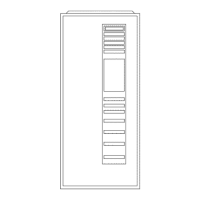5,ReconnectRleadtofhmacecontloLremovetapeI]_om blower
door switch, and re-install blower door
6, Operate f;arnace per instruction on outer door
7, Verit}- furnace shut down by lowering thermostat setting
below room temperatm'e,
8, Ve*ify that fhmace restarts by raising thermostat setting above
roon'l temperature
Step g--Adjustments
SET GAS INPI_ T RATE
Furnace gas input rate on rating plate is for installations at ahimdes
up to 2000 ft,
In the [ .S.A, the input ratings for altitudes above 2000 ft must be
reduced by 2 percent fbr each 1000 ft above sea level.
In (anada, the input ratings must be &rated by 5 percent for
altitudes of 2000 ft to 4500 ft above sea level.
Furnace input rate must be within _+2 percent of input on [_urnace
rating plate adjusted fbr ahimde.
1. Detemaine natural gas orifice size and manifbld pressure for
correct input.
a. Obtain average yearly gas heat value (at installed altitude)
fi'om local gas supplier.
b. Obtain average yearly gas specific gravi w fiom local gas
supplier.
c. Verify furnace model. Table 9 can only be used for model
58MCA furnaces with heating sizes of 040 through 120.
Table 10 can only be used for model 58MCA Nrnaces with
a heating size of 140.
d. Find installation ahimde in Table 9 or 10.
NOTE: For Canada altitudes of 200! to 4500 it, use U.S.A.
altitudes of 200! to 3000 ft in Table 9 or 10.
e. Find closest natural gas heat value and specific gravity on
Table 9 or 10.
£ Follow heat value and specific gravity lines to point of
intersection to find orifice size and mani%ld pressure
settings for proper operation.
EXAMPLE: (0 2000 ft altitude using Table 9)
Heating value 1050 Btuicu ft
Specific gravity 062
Therefbre: Orifice No. 45
Manifold pressure 3 6-in wc
* Furnace is shipped with No. 45 orifices. In this example
nil main burner orifices are the cotl'ect size and do not need
to be changed to obtain the proper input rate.
Check and verif) burner orifice size in fhrnace. NEVER ASSUME
ORIFICE SIZE; ALWAYS CHE(K AND VERIFY
2. Aciiust manifbld pressure to obtain input rate
NOTE: Manifold pressure must always be measured with burner
enclosure fiont REMOVED. Gas meter must always be clocked
with burner enclosure front INSTALLED.
a Remove burner enclosure fiont.
b. Remove cap that conceals adjustment screw for gas valve
regulator. (See Fig. 50.)
c Jumper R and W thermostat connections on control to start
_/fnace,
d. Turn adjusting screw, counterclockwise (out) to decrease
manifold pressure or clockwise (in) to increase manifbld
pressure
NOTE: This furnace has been approved %r a mani%ld pressure
of 32 in wc to 38 in. wc when installed at altitudes up to 2000 t't.
For ahimdes above 2000 ft, the manifold pressure can be adjusted
from 20 in. wc to 38 in. wc If manifPld pressure is outside this
range, change burner orifices to obtain pressure in this range
--9 UNIT DAMAGE HAZARD
Failure to follow this caution may result in reduced femace
lifk.
DO NOT bottom out gas valve regulator adjusting screw.
This can result in unregulated manifPld pressure and result in
excess overfire and heat exchanger fhilures.
NOTE: If orifice hole appears damaged or it is suspected to have
been redrilled, check orifice hole with a numbered &ill bit of
cot_'ect size. Never re&ill an orifice A burr-free and squarely
aligned orifice hole is essential for proper flame characteristics.
e Replace gas valve regulator adjustment screw cap.
£ Replace burner enclosure fiont and verii}' adjusted gas
input rate using method outlined in item 3.
[;NIT DAMAGE HAZARD
Failure to %llow this caution may result in component
damage due to flame impingement of burners and heat
exchangers.
DO NOT re&ill orifices, ha?proper drilling (burrs, out=of =
round holes, etc.) can cause excessive burner noise and
misdirection of burner flames. (See Fig. 5!.)
g. Look through sight glass in burner enclosure and check
burner flame. Burner flame should be clear blue, almost
transparent. (See Fig. 52.)
h Remove jumper fiom R and W
3. Verify natural gas input rate by clocking gas meter.
NOTE: Be sure all pressure tubing, combustion-air and vent
pipes, and burner enclosure f?ont are in place when checking input
by clocking gas meter.
a. Calculate high-altitude adjustment (if required).
UNITED STATES
At altitudes above 2000 f_, this fhmace has been approved
for a 2% derate fbr each 1000 ft above sea level. See Table
11 fbr derate multiplier factor.
EXAMPLE: 100,000 BTUN INPUT FURNACE INSTALLED AT
4300 FT.
Derate Furnace Input Rate
Furnace Bnput Rate X Multiplier at Installation
at Sea Leve_
Factor Altitude
100,000 X 0.91 01,000
39

